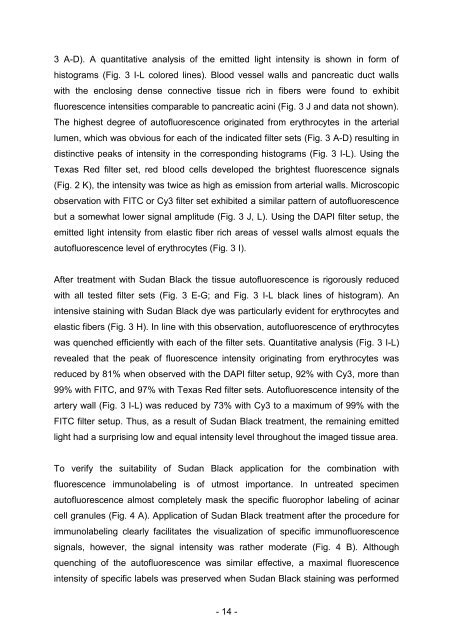Tierärztliche Hochschule Hannover - TiHo Bibliothek elib
Tierärztliche Hochschule Hannover - TiHo Bibliothek elib
Tierärztliche Hochschule Hannover - TiHo Bibliothek elib
Erfolgreiche ePaper selbst erstellen
Machen Sie aus Ihren PDF Publikationen ein blätterbares Flipbook mit unserer einzigartigen Google optimierten e-Paper Software.
3 A-D). A quantitative analysis of the emitted light intensity is shown in form of<br />
histograms (Fig. 3 I-L colored lines). Blood vessel walls and pancreatic duct walls<br />
with the enclosing dense connective tissue rich in fibers were found to exhibit<br />
fluorescence intensities comparable to pancreatic acini (Fig. 3 J and data not shown).<br />
The highest degree of autofluorescence originated from erythrocytes in the arterial<br />
lumen, which was obvious for each of the indicated filter sets (Fig. 3 A-D) resulting in<br />
distinctive peaks of intensity in the corresponding histograms (Fig. 3 I-L). Using the<br />
Texas Red filter set, red blood cells developed the brightest fluorescence signals<br />
(Fig. 2 K), the intensity was twice as high as emission from arterial walls. Microscopic<br />
observation with FITC or Cy3 filter set exhibited a similar pattern of autofluorescence<br />
but a somewhat lower signal amplitude (Fig. 3 J, L). Using the DAPI filter setup, the<br />
emitted light intensity from elastic fiber rich areas of vessel walls almost equals the<br />
autofluorescence level of erythrocytes (Fig. 3 I).<br />
After treatment with Sudan Black the tissue autofluorescence is rigorously reduced<br />
with all tested filter sets (Fig. 3 E-G; and Fig. 3 I-L black lines of histogram). An<br />
intensive staining with Sudan Black dye was particularly evident for erythrocytes and<br />
elastic fibers (Fig. 3 H). In line with this observation, autofluorescence of erythrocytes<br />
was quenched efficiently with each of the filter sets. Quantitative analysis (Fig. 3 I-L)<br />
revealed that the peak of fluorescence intensity originating from erythrocytes was<br />
reduced by 81% when observed with the DAPI filter setup, 92% with Cy3, more than<br />
99% with FITC, and 97% with Texas Red filter sets. Autofluorescence intensity of the<br />
artery wall (Fig. 3 I-L) was reduced by 73% with Cy3 to a maximum of 99% with the<br />
FITC filter setup. Thus, as a result of Sudan Black treatment, the remaining emitted<br />
light had a surprising low and equal intensity level throughout the imaged tissue area.<br />
To verify the suitability of Sudan Black application for the combination with<br />
fluorescence immunolabeling is of utmost importance. In untreated specimen<br />
autofluorescence almost completely mask the specific fluorophor labeling of acinar<br />
cell granules (Fig. 4 A). Application of Sudan Black treatment after the procedure for<br />
immunolabeling clearly facilitates the visualization of specific immunofluorescence<br />
signals, however, the signal intensity was rather moderate (Fig. 4 B). Although<br />
quenching of the autofluorescence was similar effective, a maximal fluorescence<br />
intensity of specific labels was preserved when Sudan Black staining was performed<br />
- 14 -









![Tmnsudation.] - TiHo Bibliothek elib](https://img.yumpu.com/23369022/1/174x260/tmnsudation-tiho-bibliothek-elib.jpg?quality=85)






